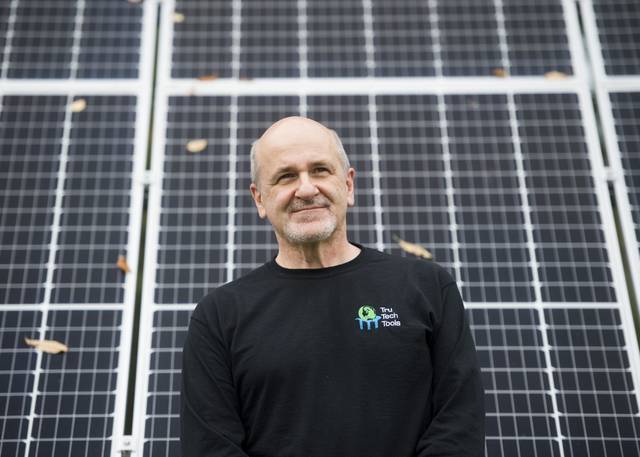https://development.triblive.com/local/regional/national-solar-tour-includes-several-pittsburgh-area-homeowners/
National Solar Tour includes several Pittsburgh-area homeowners

For Bill Spohn of Indiana Township, treading lightly when it comes to nature is a way of life he learned from having parents who lived through the Great Depression.
“They didn’t have much to go around, and they kind of instilled those values in us: respect nature, pick up after yourself,” said Spohn, who is part of the 25th annual National Solar Tour, where homeowners across the nation will virtually open their doors to give the public a look at their renewable energy set-ups.
The 100 or so tour hosts are hardly alone: According to the U.S. Department of Energy, America currently has 62.5 gigawatts’ worth of solar energy installed, enough to power 12 million homes.
The tour, which continues through Oct. 4, was started by the American Solar Energy Society, and now includes partner organization Solar United Neighbors, which organizes “solar co-ops,” grouping 20-30 homeowners interested in solar power to leverage a better price for purchase and installation.
Spohn is a member of one such local co-op.
“My career has been in energy of one sort of another,” said Spohn, who is president and co-owner of Tru Tech Tools, an Ohio-based company that provides testing equipment for heating and air-conditioning technicians, energy auditors, home inspectors and others. “It’s somewhat concerning to see the way energy is being abused, either willfully or ignorantly.”
Spohn is in the process of finishing an Indiana Township home that is equipped with a sizable solar array, but that isn’t where he started his journey to renewable energy.
“It’s two different things,” he said. “You make your home as efficient as you can, and those are usually permanent improvements to lower your energy footprint. And then I think it’s a wise choice to add solar. It can be very expensive if you just use it as a plug-in replacement (for electricity). But if you can do a load reduction in the process, I think you can see the benefits accrue much more quickly.”
Spohn began by designing a somewhat “passive” house, a concept which originated in the U.S. in the 1970s but has been more popular in Europe over the years. Passive design aims to increase a home’s overall air-tightness.
“There was this notion that houses ‘need to breathe.’ That’s not true. People need to breathe,” Spohn said. “You have to put in a system that brings in fresh air. It’s somewhat complicated, but I think the public really needs to understand how the basic physics of your house works.”
Using a slightly modified version of the passive-design concept, Spohn was able to create the energy-efficient home he’s always wanted.
Fred Kraybill, of Pittsburgh’s Point Breeze neighborhood, is also part of the National Solar Tour. But rather than use Spohn’s tactic of weatherizing his home as much as possible beforehand, Kraybill jumped into solar with both feet in 2012, placing a 7.82-kilowatt, 34-panel array on his roof before adding another 40 panels and 11 kilowatts with a second backyard array in 2013.
“I think we’re sleeping as a society on the threat that climate changes poses,” Kraybill said. “I believe we should be encouraging people to go solar if they can.”
Kraybill bought a hybrid Chevy Volt in 2011, and part of his decision to go solar was a desire to power his car with clean energy.
“The other thing is that changing the way you use energy changes the way you think about your use,” he said. “I have a friend who installed solar, and suddenly found himself turning the lights off more often.”
And while Kraybill’s second, larger array cost around $40,000, it would be significantly cheaper today.
“The first array I put in cost somewhere around $5 per watt,” he said. “Today you can get it installed for around $3 per watt. The price of solar is dropping very fast.”
Since the beginning of 2014, the average cost of a solar panel has dropped by 50%, according to U.S. Department of Energy officials.
Kraybill also touted the benefits of federal and state tax credits for homeowners who elect to use renewable energy.
“A tax credit gives people an incentive to use renewables and help level the playing field.”
Ben Delman, spokesman for Solar United Neighbors, said the tour gives participants a look at a variety of set-ups nationwide.
“It’s a great opportunity for folks to show what they’ve done with their home, and the advantages of going solar,” he said.
For Spohn, education and preparation is the key.
“I think an informed consumer makes a really good customer for the right contractor,” he said.
That information is readily available through Solar United Neighbors co-op meetings, and Spohn estimated that by leveraging the co-op’s buying power, he was able to save 30% off the cost of his solar array.
“(Solar United Neighbors) has a lot of resources and solar users like myself who can offer advice,” he said. “Solar is a good part of a holistic approach to an energy-efficient house. Reduce your footprint the best you can, and then consider substituting a different energy source like solar.”
To view tour videos, see NationalSolarTour.org.
Copyright ©2025— Trib Total Media, LLC (TribLIVE.com)
